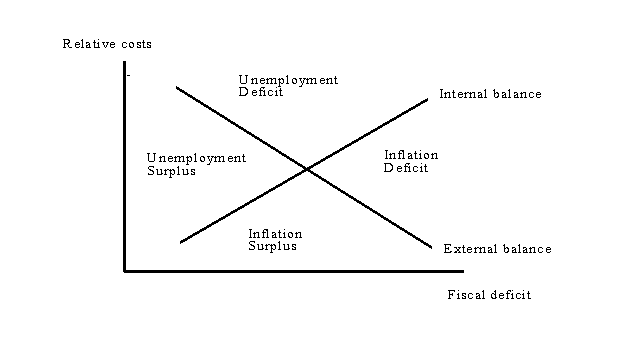The Swan Diagram/Mundell-Fleming Cont.

Swan diagram-Wiki
It looks like Krugman has another chart of interest with the article: LATIN AMERICA’S SWAN SONG

The writer has taken liberty it seems to boil absorption to only the Fiscal Side. Supply Siders might differ with that assessment.
Note this does not correspond with above diagrams, these notes are from the book where exchange rate is reversed (units of foreign exchange for a unit of domestic), and thus the chart is flipped on the curves.
On the vertical axis is the real exchange rate defined as domestic currency units per unit of foreign currency, thus lower is an appreciation and higher is a depreciation. On the horizontal axis is the amount of real domestic absorption (sum of consumption, investment and government expenditures). IB (demand) is Internal Balance-full employment and stable prices and EB (supply) is External Balance-equilibrium in Current Account. To the right of the IB are inflationary pressures (left Unemployment). To the right of the EB is CA deficit (left/ surplus).
The Swan diagram concentrates on the relation between internal equilibrium on the current account of the balance of payments (not the capital account); and it uses the absorption approach, the model you studied in the previous unit (unit 3). Pilbeam mentions two distinct trypes of policy designed to change the current account of the balance of payments (page 76): expenditure switching and expenditure changing policies (the latter are often called 'expenditure reducing' policies.
Thus many times to achieve both internal and external balance it is needed two tools to do this as elaborated by Jan Tinbergen (1952) which became the Tinbergen's Instruments-Targets Rule.
The article by the Australian Government Treasury is entitled The Chinese currency: how undervalued and how much does it matter?
Opportunity costs also arise from the fact that accumulated foreign reserves could have otherwise been used to repay its foreign debt (estimated at 5 per cent of GDP). Interest rates paid by China on its external borrowing are higher than those received on its foreign reserve assets. Yields on long-term Chinese government external debt (about a quarter of the total) have recently been 60-70 basis points above US Treasury yields, and spreads on other debt are likely to be higher.
There is also a large exposure to future currency losses. China’s foreign reserves were equal to 38 per cent of GDP at the end of 2004. Assuming at least 80 per cent of these reserves are dollar-denominated, each 10 per cent appreciation against the dollar would mean a currency loss equivalent to about 3 per cent of GDP. Potential losses increase the longer China continues to accumulate reserves to hold down the RMB.
...
Hence, RMB adjustment would need to be combined with measures to expand domestic demand in China in order to have a significant impact on external imbalances. Given that Chinese investment is already very high, this will most likely take the form of measures to address factors contributing to China’s high saving rate. These factors include financial underdevelopment, limited social safety nets and corporate governance shortcomings that contribute to high corporate saving. While exchange rate adjustment is important, it should not be overemphasised at the expense of other elements required to address imbalances.
...
The appropriate rate of adjustment will also depend on whether the PBoC can continue to sterilise the monetary impacts of reserve accumulation. If monetary control becomes more difficult, there may be an argument for a faster pace of adjustment. Excessive monetary expansion would only aggravate future financial sector problems. One of the problems associated with a gradual approach is that speculative inflows are more likely to persist because the currency is seen as a ‘one way bet’ , which means continued high reserve accumulation.
Labels: DF201, FE201, Macro-Economics


0 Comments:
Post a Comment
<< Home